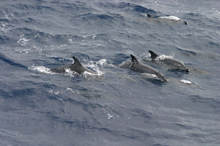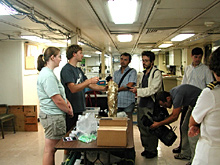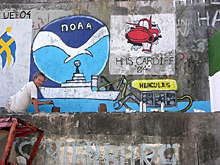
A pod of dolphins swimming toward the bow of the Ronald H. Brown in the early morning of August 8.
![]() Click image to view a slide show.
Click image to view a slide show.
Pickups and Deliveries
August 8, 2005
Pete Wiley
Web Coordinator
NOAA Office of Ocean Exploration
The logistics involved in getting a research expedition kicked off can be daunting under the best circumstances. For North Atlantic Stepping Stones, the challenges were magnified by back-to-back cruises (the Lost City expedition just wrapped up), equipment difficulties, and staging from a foreign port. The scientific party and crew are taking these challenges in stride while trying to sneak in a little sightseeing in Sao Miguel. We are currently standing off shore, while upgrading our dynamic positioning system and waiting for some spare parts (and some luggage) that have not yet arrived. The feeling from leaving port, of having started the expedition is an illusion, as Ponta Delgada is still in sight.

Kate Buckman and Giora Proskurowski, both of the Woods Hole Oceanographic Institution, describe the science associated with the Lost City hydrothermal vent fields and a partial chimney from the vent fields to the Azorian press. Click image for larger view.
Given the ambitious set of objectives laid out for this expedition, time is precious; and every hour that goes by means one more hour that we are not diving on seamounts. But the positioning system is critical, for both navigating the ship, and keeping the ship in the correct position relative to the ROV. The need to be fully prepared is paramount on a cruise such as this, as going back to port or obtaining additional equipment is not an option. The prospect of losing time in lengthy repairs is also something the team tries very hard to avoid. On the bright side, the delay allows for the new members of the science party to get to know each other, for additional planning, and to fall into the routine of ship life and getting their “sea legs.”
Before leaving, the outgoing science party and the hardy contingent who will be present for both legs of the cruise (Lost City and North Atlantic Stepping stones) also conducted a press conference and tour of the ship to representatives of the American Consulate, as well as visiting educators, allowing them to display some of the samples taken from the Lost City dive sites. As overwhelming as it is to continue to prepare for the upcoming cruise, the PR aspect of ocean exploration is a vital component that also requires the time and energy of the team.
NOAA Ship Ronald H. Brown Chief Boatswain Bruce Cowden putting the finishing touches on a painting at the port in Ponta Delgada. It is a tradition in some ports for visiting ships to paint a logo, emblem or some other image to commemorate their visit. Click image for larger view.
Sign up for the Ocean Explorer E-mail Update List.
























